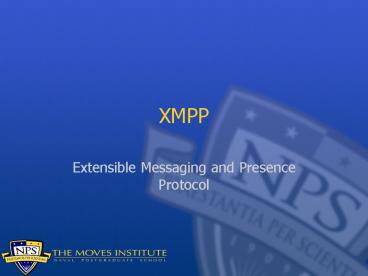XMPP - PowerPoint PPT Presentation
1 / 20
Title:
XMPP
Description:
... devices that listen on an XMPP chat room or that exchange information directly. ... It allows several users to be in a chat room. ... – PowerPoint PPT presentation
Number of Views:359
Avg rating:3.0/5.0
Title: XMPP
1
XMPP
- Extensible Messaging and Presence Protocol
2
Chat
- In the beginning there was instant messaging and
chat. - Lots of binary standards
- Unix talk, IRC, AOL Instant Messaging (AIM)
Yahoo, MS, etc. - The commercial implementations quickly tried to
achieve user lock-in via proprietary protocols.
(Aside you make money in the computer industry
by owning standards, such as the Windows API. If
you own the standard you can lock other
implementors out.)
3
Better Way
- Why not do something open standards that any one
can implement. - Which is what XMPP is--open standard, published
by the IETF, that uses XML to exchange
information. - XML allows user-readability the classic benefits
of XML
4
Whats Handled?
- Presence who is online right now? Are they
willing to talk? - Instant Messaging real-time communications
between two or more users - real time roughly means that you see the
text each time the user hits return - Some show each character as it is typed
- Chat groups of people exchanging information in
a chat room - Information exchange Since XMPP uses XML, we can
exchange information that can be expressed in XML
5
Presence Buddy List
My status--available for IMs
Buddies
Off Line buddies
6
How Does XMPP Work?
ltmessage to'romeo_at_example.net'
from'juliet_at_example.com/balcony'
type'chat'
xmllang'en'gt ltbodygtWherefore art
thou, Romeo?lt/bodygt lt/messagegt
7
XMPP Stanzas
- There are three basic stanzas or elements in
XMPP - message
- presence here I am. Tell all my subscribers
about my status - iq info/query, request/response
- In addition these elements all have five common
attributes defined - to JID of recipient
- from JID of sender
- id can be a unique ID assigned to each stanza
- type varies by stanza
- xmllang used to specify human language
8
XMPP
Server
Client
TCP connection between client and server.
Typically this is negotiated over SSL or TLS (a
follow-on version of SSL) so that the traffic is
encrypted and secure. XML stanzas are exchanged
across this channel
9
XMPP
- The XML is sent as an open-ended stream. A stream
starts with ltstreamgt, then an open-ended series
of ltpresencegt, ltmessagegt, and ltiqgt tags are sent. - When the closing lt/streamgt tag is sent, the
underlying TCP connection is torn down
10
XML Communications Backplane
- We can also add new XML to the existing standard
to get new capabilities - You should think of XMPP not as strictly chat,
but as an XML-enabled communications backplane - Anyone can subscribe to a server and receive XML
messages from other users. We can use this as a
way to do lots of things besides chat.
11
XMPP
Device
User
XMPP Communications
Device
User
12
Communications
- You can place programs or devices that listen on
an XMPP chat room or that exchange information
directly. - Now there are devices or programs listening
rather than humans - Can use XML to exchange data objects
- You can also tie in XMPP with multimedia,
including voice - The jingle API (included w/ smack) allows voice
13
XMPP Basics
- You have a client that connects to and
authenticates to a server. - Users are uniquely identified by their JID, in
the form username_at_fqhn.com, eg jamesbond_at_mi6.gov.u
k
14
Multi User Chat (MUC)
- Multiuser chat is an add-on to the XMPP
specification. It allows several users to be in a
chat room. - The convention is for a chat server to have the
DNS name conference.machine.name, eg
conference.savage.nps.edu - The muc is identified by the jid
roomname_at_conference.machine.name, eg - Moves_at_conference.savage.nps.edu
15
Server-to-Server
- Notice that a client connects to a local server,
but the JID for a chat or muc may be on another
machine - Example you log onto savage.nps.edu, and you
specify that you want to chat with someone at
smith_at_googletalk.com - (For firewall reasons this wont work right now.)
- To do this, the server you have logged onto
establishes a server-to-server connection to the
machine specified in the JID
16
Server-to-Server
remote.com
Local.com
Local Chat Server
Remote Chat Server
Client Foo_at_local.com
Client Bar_at_remote.com
17
Server-to-Server
- If the user isnt on the same box that you logged
onto, the server will contact the server the user
is logged onto and pass the message to that
server - The users do not need to be logged onto the same
machine to chat with each other
18
APIs
- What does it take to write an XMPP participant?
It turns out, not very much. - The Smack API from Ignite Realtime lets you get
up and running fairly quickly. - The examples Ill show use the Smack 3.0 API
available at http//www.igniterealtime.org/downloa
ds/index.jsp
19
Smack API
// Creates a new connection, using TLS if
possible. XMPPConnection connection
new XMPPConnection("savage.nps.edu") connection.c
onnect() // Login connection.login("testuser",
"foobar")
20
Smack API
MultiUserChat muc new MultiUserChat(connectio
n,
"moves_at_conference.savage.nps.edu"
) muc.join("studmuffin") for(int
idx 0 idx lt 10 idx)
muc.sendMessage("Hello world")
Thread.sleep(1000)

